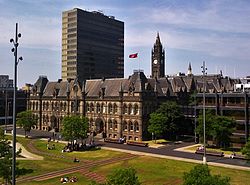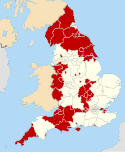| Middlesbrough Council | |
|---|---|
 Coat of arms Coat of arms | |
| Leadership | |
| Chair | Cllr Julia Rostron, Labour since 24 May 2023 |
| Mayor | Chris Cooke, Labour since 8 May 2023 |
| Deputy Mayor | Cllr Philippa Storey, Labour since 9 May 2023 |
| Chief Executive | Erik Scollay since 27 November 2024 |
| Structure | |
| Seats | 47 (46 councillors plus elected mayor) |
| Political groups |
|
| Joint committees | Tees Valley Combined Authority |
| Elections | |
| Voting system | First past the post |
| Last election | 4 May 2023 |
| Next election | 6 May 2027 |
| Meeting place | |
 | |
| Middlesbrough Town Hall | |
| Website | |
| www | |
Middlesbrough Council, formerly Middlesbrough Borough Council, is the unitary authority covering the Borough of Middlesbrough, North Yorkshire, England. Following the 2023 local elections, Labour has held majority control of the council, which meets at the Town Hall. It is led by the directly-elected Mayor of Middlesbrough (Chris Cooke since 2023). The council is a member of the Tees Valley Combined Authority.
History
The town of Middlesbrough had been incorporated as a municipal borough in 1853. When elected county councils were established in 1889 it was considered large enough to provide its own county-level services, and so it was made a county borough, independent from the new North Riding County Council, whilst remaining part of the North Riding of Yorkshire for ceremonial purposes.
The original borough of Middlesbrough was abolished in 1968, merging with several neighbouring authorities to become the County Borough of Teesside. That proved to be a short-lived local authority, being abolished just six years later when a new borough of Middlesbrough was created on 1 April 1974 under the Local Government Act 1972. The new borough covered the wards from Teesside which generally corresponded to both the pre-1968 borough and the former parishes of Hemlington, Marton and Stainton (which had all been abolished and absorbed into Teesside in 1968), plus the parish of Nunthorpe from the Stokesley Rural District. The re-created borough was a lower-tier district, being one of four districts within the new county of Cleveland. The county council provided county-level functions.
Cleveland County Council was abolished in 1996 following the Banham Review and the borough council took over county-level functions, in effect restoring Middlesbrough to the powers it had held prior to 1968 when it had been a county borough. The way the 1996 change was implemented was to create a new non-metropolitan county of Middlesbrough covering the same area as the existing borough, but with no separate county council; instead the existing borough council took on county functions, making it a unitary authority. At the same time the borough was transferred for ceremonial purposes to North Yorkshire, but as a unitary authority it has always been independent from North Yorkshire Council.
Governance
Middlesbrough Council provides both county-level and district-level services. There are two civil parishes in the borough at Nunthorpe and Stainton and Thornton which form a second tier of local government for their areas; while the rest of the borough is unparished.
Since 2016, the council has been a member of the Tees Valley Combined Authority.
Political control
The council has been under Labour majority control since the 2023 election.
Political control of the council since it was re-established in 1974 has been as follows:
Non-metropolitan district
| Party in control | Years | |
|---|---|---|
| Labour | 1974–1996 | |
Unitary authority
| Party in control | Years | |
|---|---|---|
| Labour | 1996–2019 | |
| No overall control | 2019–2023 | |
| Labour | 2023–present | |
Leadership
Since 2002, political leadership on the council has been provided by the directly elected Mayor of Middlesbrough. Prior to 2002 the council was led by a leader of the council, and the mayor was a more ceremonial role. The leaders from 1981 to 2002 were:
| Councillor | Party | From | To | |
|---|---|---|---|---|
| Walter Ferrier | Labour | 1981 | 1983 | |
| Michael Carr | Labour | 1983 | 1995 | |
| Ken Walker | Labour | 1995 | 5 May 2002 | |
The directly elected mayors since 2002 have been:
| Mayor | Party | From | To | |
|---|---|---|---|---|
| Ray Mallon | Independent | 6 May 2002 | 10 May 2015 | |
| Dave Budd | Labour | 11 May 2015 | 5 May 2019 | |
| Andy Preston | Independent | 6 May 2019 | 7 May 2023 | |
| Chris Cooke | Labour | 8 May 2023 | ||
Composition
Following the 2023 election and subsequent by-elections in 2023 and 2024, Labour have 24 councillors (excluding the mayor), the Conservatives have 4 councillors, and the Liberal Democrats have 2 councillors. Of the 16 independent councillors, twelve sit together as the "Middlesbrough Independent Councillors Association" and two form the "Marton East Independents"; the other two do not belong to a group. The next all-out election is due in 2027.
Elections
See also: Middlesbrough Council electionsSince the last full review of boundaries in 2015 the council has comprised 43 councillors representing 20 wards, with each ward electing one, two or three councillors. Elections are held every four years.
The Executive
Middlesbrough Council's senior decision making body is a committee known as the Executive. Similar to a cabinet, the Executive consists of the Mayor and up to nine councillors appointed by the Mayor, as of November 2024 they are as follows:
- Mayor Chris Cooke
- Cllr Philippa Storey, Deputy Mayor and Executive Member for Education and Culture
- Cllr Jan Ryles, Executive Member for Adult Social Care and Public Health
- Cllr Peter Gavigan, Executive Member for Environment and Sustainability
- Cllr Theo Furness, Executive Member for Development
- Cllr Janet Thompson, Executive Member for Neighbourhoods
- Cllr Nicky Walker, Executive Member for Finance
- Cllr Luke Henman, Executive Member for Children's Services
Premises
The council is based at Middlesbrough Town Hall on Albert Road in the centre of Middlesbrough. The building is in two parts, being the main hall on the corner of Corporation Road (primarily an entertainment venue) and the Municipal Buildings to the south of the hall, facing Centre Square, which were built together between 1883 and 1889. The council has additional offices in modern buildings near the Town Hall, notably at Middlesbrough House at 50 Corporation Road, which includes the customer centre, and at Fountain Court at 119 Grange Road.

The council's main offices were previously at the Civic Centre on Centre Square, immediately east of the Municipal Buildings and linked to them by a first floor bridge. The Civic Centre was completed in 1973. The council vacated the Civic Centre in 2022 after purchasing nearby Fountain Court and relocating staff there.
Coat of arms

The motto Erimus ("We shall be" in Latin) was adopted, it reflects Fuimus ("We have been") of the Bruce clan which were Cleveland's mediaeval lords.
The original arms was granted to the Middlesbrough Rural District in 1911 by William Hylton Dyer Longstaffe. The town's coat of arms were three ships representing shipbuilding and maritime trade and an azure (blue) lion, the latter also from the Bruce clan. It was regranted in 1996 with slight modifications after the dissolution of Cleveland county: a star replaced the middle ship, this is from Captain James Cook's coat of arms.
References
- "Middlesbrough's coat of arms". Middlesbrough.gov.uk. Archived from the original on 1 November 2020. Retrieved 25 August 2022.
"Middlesbrough". Heraldry of the World. Retrieved 25 August 2022. - "Council minutes, 24 May 2023". Middlesbrough Council. 24 May 2023. Retrieved 25 February 2024.
- Georgia, Banks (11 May 2023). "New Middlesbrough mayor Chris Cooke names Executive team". Teesside Gazette. Retrieved 9 December 2024.
- Georgia, Banks (14 November 2024). "Middlesbrough Council set to appoint former Royal Navy Lieutenant as new permanent chief executive". Teesside Gazette. Retrieved 9 December 2024.
- "Your councillors by party". Middlesbrough Council. Retrieved 25 February 2024.
- "Middlesbrough Improvement Act 1856". legislation.gov.uk. The National Archives. Retrieved 25 February 2024.
- "Local Government Act 1888". legislation.gov.uk. The National Archives. 1888 c. 41. Retrieved 25 February 2024.
- "The English Non-metropolitan Districts (Definition) Order 1972". legislation.gov.uk. The National Archives. SI 1972/2039. Retrieved 3 March 2023.
- "The Cleveland (Structural Change) Order 1995". legislation.gov.uk. The National Archives. SI 1995/187. Retrieved 25 February 2024.
- "The Local Government Changes for England (Miscellaneous Provision) Regulations 1995", legislation.gov.uk, The National Archives, SI 1995/1748, retrieved 6 March 2024
- "Lieutenancies Act 1997". legislation.gov.uk. The National Archives. 1997 c. 23. Retrieved 25 February 2024.
- "Election Maps". Ordnance Survey. Retrieved 25 February 2024.
- "The Tees Valley Combined Authority Order 2016". legislation.gov.uk. The National Archives. SI 2016/449. Retrieved 25 February 2024.
- Lightfoot, Gareth; Arnold, Stuart; Craigie, Emily (6 May 2023). "RECAP: Labour gain control of Middlesbrough Council". TeessideLive. Retrieved 7 May 2023.
- "Compositions calculator". The Elections Centre. 4 March 2016. Retrieved 9 September 2022.
- Robson, Dave (9 March 2015). "Councillor Walter Ferrier who spent 57 years serving the people of Middlesbrough has died". Teesside Live. Retrieved 22 February 2024.
- Dale, Sarah (10 October 2014). "Middlesbrough councillor receives OBE at Buckingham Palace". Teesside Live. Retrieved 22 February 2014.
- McKenzie, Sandy (6 April 2009). "Ex Middlesbrough Council leader tells of his regrets". Teesside Live. Retrieved 22 February 2024.
- "Leader's mission to modify is over at last". Northern Echo. 1 May 2002. Retrieved 22 February 2024.
- Voce, Antonio; Leach, Anna; Hoog, Niels de; Torpey, Paul; Clarke, Seán (9 May 2023). "Local elections 2023: live council results for England". The Guardian.
- Lightfoot, Gareth (18 August 2023). "Independent councillor elected to Middlesbrough Council in by-election". Teesside Live. Retrieved 25 February 2024.
- "The Middlesbrough (Electoral Changes) Order 2014". legislation.gov.uk. The National Archives. SI 2014/1188. Retrieved 25 February 2024.
- "MIDDLESBROUGH COUNCIL COMMITTEES, MEMBERSHIPS AND TERMS OF REFERENCE FOR THE EXECUTIVE (EXCLUDING PORTFOLIOS) AND COMMITTEES OF THE COUNCIL 2021/2022" (PDF). Middlesbrough Council. Retrieved 29 July 2023.
- "Committee details – Executive". moderngov.middlesbrough.gov.uk. 29 July 2023. Retrieved 29 July 2023.
- Historic England. "Town Hall and Municipal Buildings (Grade II*) (1136659)". National Heritage List for England. Retrieved 25 February 2024.
- "Middlesbrough House Customer Centre". Middlesbrough Council. Retrieved 25 February 2024.
- "Services provided by the council". Middlesbrough Council. Retrieved 25 February 2024.
- Phipps, Simon (2020). Brutal North: Post-war modernist architecture in the North of England. September Publishing. p. 91. ISBN 9781912836468. Retrieved 25 February 2024.
- Metcalfe, Alex (9 March 2021). "Former call centre emerges as frontrunner to become council's new home". Teesside Live. Retrieved 25 February 2024.
- GENUKI: Middlesbrough Parish information from Bulmers' 1890
- "Heraldry Society". Archived from the original on 14 May 2008. Retrieved 13 December 2007.
- "Robert Young's Civic Heraldry website".
- "Middlesbrough Borough Council". Civic Heraldry of England and Wales. Archived from the original on 18 April 2015. Retrieved 28 May 2015.
External links
| Local authorities in North Yorkshire | |
|---|---|
| Unitary | |
| Combined Authority | |
| Former | |
54°34′32″N 1°14′02″W / 54.5755°N 1.234°W / 54.5755; -1.234
Categories: